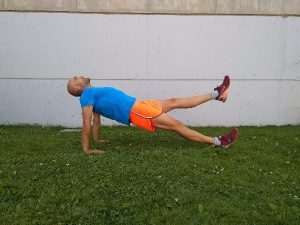
Briefly, remember the basic guidelines for performing these types of exercises:
Next we show you the exercise proposal. The idea is to get to perform between 10 and 15 repetitions of each exercise and repeat the entire circuit 3 or 4 times:
Front plate with change of supports.
In the front iron position, alternate the position of your feet by opening and closing them. You can do it one by one (easier) or simultaneously with a small jump (more difficult).
Side plate with elevation and rotation.
In the side plate position, with the free arm extended toward the ceiling, perform a hip lowering and elevation and then a forward rotation crossing the free arm below the chest.
Inverted iron with leg lift.
Place yourself in an inverted iron position with your hips raised and, alternatively, raise one leg fully extended up to your hip height.
Background + side plate.
Make a flexion of arms and when the extension turns to one side to place you in position side plate supporting a hand. Make another flex with both arms and turn to the other side.
Inverted iron with two supports.
In reverse plate position, support the sole of the feet with the knees bent in 90o and the hips elevated. Alternatively, extend and raise one leg at the same time you try to touch your foot with the opposite hand.
Superman pro.
Support your hands in the vertical of the shoulders and the tips of the feet keeping the legs together. Stretch the opposite leg and arm and hold the pose for about 5 seconds. Change sides.
It is a good idea to include it before or after any of your race or swimming workouts, this will be part of your training routine and you will not be lazy to get down to work with your core.
Photos: Nacho Jiménez Triathlon coach
Laura García Cervantes
Dra. Science of Physical Activity and Sport
Technical Director Club Trikatlón Tres Cantos
Triathlon and Swimming Senior Trainer
Paratriathlon Specialist Trainer